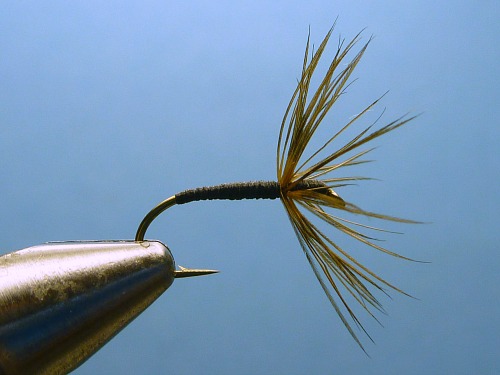Tenkara Fishing in Alpine Lakes
by Jason Klass
When most people think of tenkara, they usually associate it with small streams. And rightfully so. Tenkara is an ideal style for surgically fishing the diverse structures of small streams. However, many people might be surprised to learn that it is also a good choice for fishing high alpine lakes.
Fishing these remote lakes often happens on overnight or multi-day backpacking trips and the compact design and lack of reel make tenkara rods a great choice for the weight-conscious backpacker. Plus, the longer 12-15 ft. rod length helps too!
But you might be wondering how a fixed-line rod with limited casting distance could possibly be used in lake fishing. After all, lakes are much bigger than small streams and there’s much more water to cover. You need to be able to make long casts when you’re lake fishing, right?
To understand why tenkara fishing in alpine lakes actually does work, you first have to understand a fundamental difference between how fish behave in streams vs. how they behave in lakes.
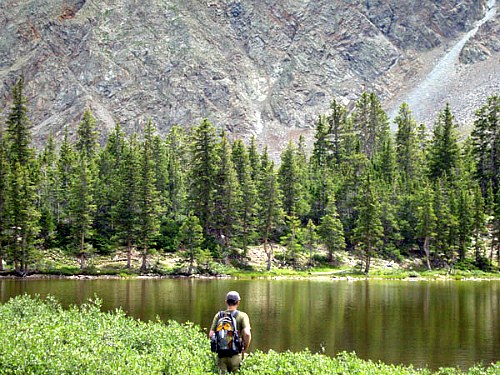 Watch for cruising fish before casting.
Watch for cruising fish before casting.
Stream Vs. Lake Fishing
In streams, the fish hold in specific places—behind a rock, under a log, at the tail of a pool, etc. For the most part, they are stationary and the food (drifting insects) comes to them. They have it pretty easy. But in lakes (especially alpine lakes), it’s a completely different story.
In lakes, trout aren’t stationary. They are constantly cruising around looking for food. Altitude limits the abundance of insect life, which means the higher the elevation, the scarcer the food. However, this can be good news for the angler because these fish have to be pretty opportunistic, more competitive, and a little less picky to survive.
So, what does this mean from an angler’s perspective? In streams, we have to read the water to determine where the fish are and move from spot to spot making our presentation. I.e., we move. The fish don’t.
In lake fishing, it’s the opposite. The fish move, but we don’t (or don’t have to). As I mentioned above, trout in lakes cruise around looking for food in (sometimes) predictable patterns. So, that means you can stay in one spot and wait for the fish to come to you. And this is why tenkara fishing in alpine lakes works even though you can’t shoot 60 ft. of line. I’ll explain below.
How to approach alpine lakes with tenkara
Luckily, most alpine lakes are clear so sight fishing is the norm. The first thing I do when I approach a lake is to scan the water to see if I can find pods of cruising fish. Sometimes, I stand there until I can track their pattern before I even start casting so I know a good place to position myself (a place that has the most traffic).
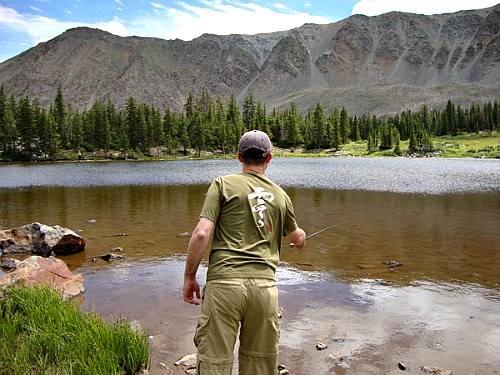 Fishing from shore.
Fishing from shore.I usually fish from shore if possible. Fish like to cruise the shoreline but if it’s too shallow, then I’ll wade out to where I can cast to where the fish are cruising. I don’t just start casting randomly. I wait for an approaching pod of fish and then cast my fly ahead of them—to where I think they’ll swim right to it. There is some timing involved. Cast too close to them and you might spook them. Cast too far ahead, and they might change course on you and never see it. It takes a little practice to figure out the right distance. But a good general rule of thumb is that you should be casting about 5-6 feet in front of the pod.
Of course, fly selection and water conditions will determine the right distance. For example, with a dry fly that will land a little more delicately, you can probably cast closer and tighten the window of opportunity. But with a fly you want to sink and if you’re in deeper water, you might need to cast further ahead to allow the fly to sink in time. You have to calculate the speed and distance of the cruising trout vs. the sink rate of your fly vs. the depth of the water to determine how far ahead will you have to cast to allow your fly to get to the right depth by the time the trout reach it. It sounds more complicated than it really is. You just have to practice. If you screw it up, don’t worry. More fish will be coming by soon and you’ll get another shot!
Resist the temptation to move to another spot. If you miss a pod or make a bad presentation, just pull in your line, and wait for the next pod to come along. Be more of a hunter than an angler.
Lake Structure
Some high-altitude lakes have little structure to speak of. They’re just empty “craters” filled with water. In this case, you can pretty much position yourself anywhere and wait for the fish to come. That makes life easy—any spot is a good one.
One exception to this is if it’s very windy. Wind tends to create an artificial current in small lakes that pushes aquatic insects and other food sources toward the leeward shore. When this happens, fish will congregate on the leeward side of the lake since that’s where the food is. So even though you might not have to worry about structure, your best bet is to pick a spot on the leeward shore of the lake.
Of course, not all alpine lakes are just empty bowls and some can have quite interesting structure to read. It’s not that trout will necessarily “hold” near this structure the way a bass or stream trout would, but they will adjust their cruising patterns based on it and some types of lake structure will act as magnets that dictate the cruising pattern the fish will follow.
Understanding lake structure is beyond the scope of this article and is a topic in itself. But basically, you can get a quick read of a lake’s structure and with a little patient observation, figure out which types of structure the fish are cruising by and which ones they’re not.
I like to look for points or rock outcroppings where I can position myself because trout seem to like cruising by points and it gives me a good vantage point with a near 360 degree casting range.
Of course, large rocks and boulders can be popular drive bys, so pay close attention to those too.
If there is vegetation in the lake, look along the edges as fish will often cruise parallel to them, looking for the insects and other creatures that like to hide there.
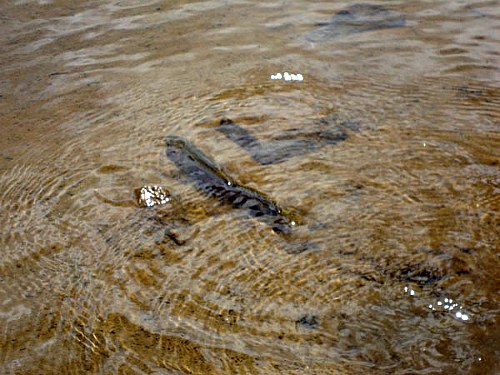
Flats are also good to try. I’m always amazed at how often I see trout cruising shallow, silty water that I would normally consider “dead” water. My observation is that typically loner trout cruise such shallow flats while the pods cruise mostly in deeper water. Presentation here can be a little tricky because the water is so skinny but if you get it right, you should be able to scope out and target an individual fish fairly easily.
Other things to look for are inlets and outlets of streams. This is an exception to everything I’ve been talking about in this article because here, the fish essentially behave like stream trout. They’ll hold in the current facing upstream and let the food come to them. Fishing inlets and outlets pretty much reverts you back to stream fishing, so those rules apply.
Time of Day
Like most fishing, the best times of day for tenkara fishing in alpine lakes can be the early morning and late afternoon/evening; however, I find that since the fish are relatively food deprived, they have to take it when they can get it. I consistently catch fish right in the middle of the day and so I don’t pay too much attention to timing when it comes to fishing these types of lakes. Also, I find that it’s much easier to spot fish when the sun is high and creates a shadow directly under them that really makes them stand out. Since the fish don’t seem to care much about the time of day, neither do I.
Flies and Presentation
As mentioned above, fish in alpine lakes are opportunistic and competitive—they have to be. If fish are rising to a hatch, I’ll usually try to match it. Often, this means midges and a simple #20 Griffith’s Gnat will do the trick. For mayflies, simple blue-winged olive patterns in #18 or #20 do well. Fishing dry flies in lakes is much like fishing them in streams. You cast it out there, watch the fly and wait for the strike. If you’re on a good hatch with lots of fish rising, you can probably cast anywhere and a fish will eventually take it. You just have to be patient and let your fly sit there until you get a taker. The trick is to be able to see your fly and differentiate it from the naturals. If there’s no hatch and few risers, just cast ahead of a cruising pod of fish as I mentioned earlier. Often, you will be able to see a fish dart up to your dry fly and hit it. This is one of my favorite phenomena in fly fishing because with the clear water, you get to see—in full detail—the fish notice your fly, decide to go for it, and then swim up to it and take it. You see more detail than in streams where the current might obscure everything to the point that you only see the final splash of the rise on the surface. In clear alpine lakes, you see the whole story, not just the finale.
But when there’s no hatch, that’s when you get to use the alpine lake trout’s competitive nature to your advantage. Typically, when I see a pod of fish approaching, I will cast a simple sakasa kebari in a size #14 or #12 and let it sink down until it’s almost on the bottom. Then, when the fish are just a few feet away from it, I’ll start retrieving it in short, slow pulses, keeping it about mid-column. Once it catches the fishes’ attention, they all want to get it before the other guy does. They start trying to outrun each other, aggressively chasing the fly and attacking it with an aggressive strike. It’s the closest thing to bonefishing you’ll find at 10,000 feet!
Rods
As you might suspect longer rods are best for tenkara fishing in alpine lakes. In fact, I can’t think of a situation where a shorter rod would be better. Obviously, the longer the rod, the more distance you’ll get. But, particularly, if you’re fishing from shore, it also gives you the advantage of being able to stay further back from the shoreline or crouch down to reduce your profile and fish more stealthily.
There are two rods I’d recommend for lake fishing. The Tenkara USA Amago is a 13’ 6” rod that I have been using for a long time for tenkara fishing in lakes. It’s got a slightly stiffer 6:4 action, which allows it to cast very well in the wind and the length is just right.
The other rod I’d recommend is the Tenkara USA Ito. The Ito is a “zoom” rod, meaning that it can adjust between two different lengths: 13’ or 14’ 7”. This means that when you need the extra reach, you can simply “zoom” the rod out to a nearly 15’ length. There are times when even an extra foot or so can make a big difference!
Lines
While any tenkara line will work for lake fishing, I tend to prefer fluorocarbon level lines. They slice though the wind very well and wind can definitely be a challenge on alpine lakes. If I need to make a more delicate presentation, I’ll choose a #3. If it’s windy, I’ll bump it up to a #4 or even a #4.5.
Another reason I like level lines is that they tend to spray less than furled lines and are less likely to scare the fish. Again, this is more critical if the surface is smooth, but if you do use a furled line, make sure you do not cast directly over the fish with a wet line. They’ll be out of there.
For length, I typically fish a 13 ft. line with 3-5 ft. of tippet. Of course, if you need more distance, you can go as long as a 20 ft. line but I find I can usually get away with a line about as long as the rod plus the tippet.
I only really use two tippet sizes for tenkara fishing in alpine lakes: 5X and 7X. I use the stronger 5X for sinking flies like sakasa kebari (because the strike is more aggressive) and the 7X for smaller flies like the Griffith’s Gnat where a more delicate presentation is required on very calm, clear water. Hey, the fish might be somewhat desperate but they’re not stupid!
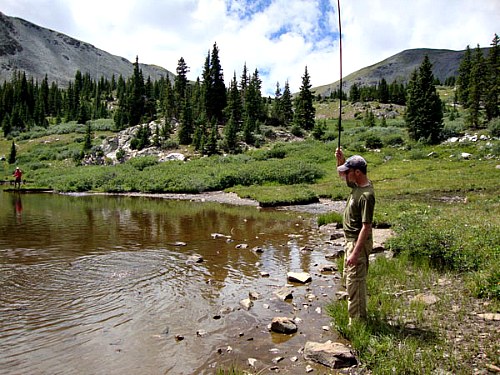 Success!
Success!Recommended Reading
Of course this short article is by no means an exhaustive treatment of fly fishing in alpine lakes. It’s really just to get you to consider trying tenkara outside of the small streams in which it sometimes gets pigeonholed. While not specific to tenkara, Fly Fishing the Mountain Lakes by Gary LaFontaine is probably one of the best books ever written on the subject and I highly recommend it if you want to learn more about lake fishing in the high country while being entertained at the same time. But I also encourage you to to not take my word for it and bring a tenkara rod along the next time you’re heading to a mountain lake.
If you are thinking of fishing the alpine lakes in Rocky Mountain National Park you might also consider The Fly Fishing Guide to Rocky Mountain National Park by Steve Schweitzer. All high mountain lakes are beautiful, but not all hold trout. If your primary goal is the backpacking, take the tenkara rod just in case. If your primary goal is the fishing, read the guide book, just in case.
Give it a Try!
So if you’ve always thought tenkara was just for small stream fishing, you might want to try it on some tenkara fishing in alpine lakes for a different experience. And if you’re backpacking, tenkara is a great way to combine two sports you love without weighing you down.
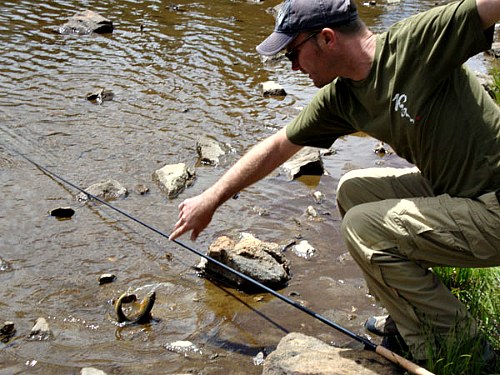

Jason Klass is a former fly fishing guide who now exclusively fishes Tenkara for trout in the streams and alpine lakes of Colorado. Jason writes about tenkara on
TenkaraTalk a tenkara fly fishing blog.
TenkaraBum Home > Tenkara Techniques > Tenkara Fishing in Alpine Lakes
“The bitterness of poor quality remains long after the sweetness of low price is forgotten” - Benjamin Franklin
"Be sure in casting, that your fly fall first into the water, for if the line fall first, it scares or frightens the fish..." -
Col. Robert Venables 1662
As age slows my pace, I will become more like the heron.
Warning:
The hooks are sharp.
The coffee's hot.
The fish are slippery when wet.
Beware of the Dogma
Currently processing orders that were received Mar 8.
